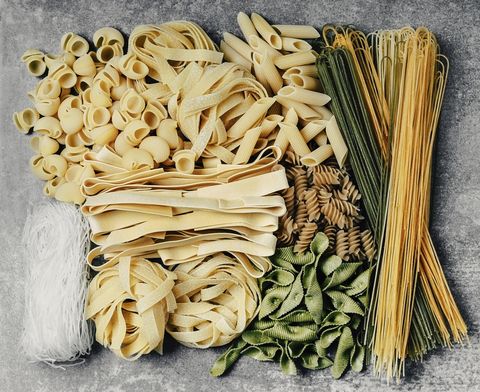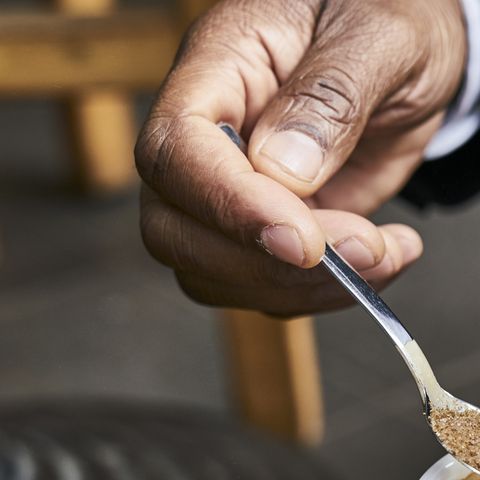Rejoice eaters! The era of meticulous calorie counting is over. And good riddance, because the conventional “calories in/calories out” model ignores one key factor: the quality of your food.
Instead of counting calories, consider a 2017 New Zealand study suggesting that a diet centered on consuming whole foods like vegetables, legumes, whole grains, and fruits freely until you’re satisfied can lead to sustainable weight loss.
To break it down even more: “Monitoring the macronutrient composition of your diet—protein, carbohydrates, fat—is more important by far than counting calories,” says Mike Roussell, Ph.D., R.D., author of The MetaShred Diet.
Do that and you’ll cut the junk, net more disease-fighting antioxidants,and drop the pounds you’ve wanted to lose for years.
But wait, how did calories grow in importance anyhow? First, a very important history lesson.
The Calorie Backlash
Count calories, skip the fat: For 40 years, these have been the twin pillars of most mainstream weight loss advice. But according to David Ludwig, M.D., Ph.D., author of the 2016 bestseller Always Hungry?, the best way to lose weight is to do neither.
Fat is not the villain, he writes; processed carbohydrates are. And put down the low-fat Twinkies! “For 40 years we gobbled up lowfat foods,” he says, “but they were actually making us fatter because they were filled with processed carbs instead of fat.”

Getty Images
Epidemiological data backs him up: The rise in obesity rates began in the late 1970s, around the same time the U.S. Department of Agriculture began recommending that Americans eat a low-fat diet. After 30 years of scientific research and watching his patients struggle with their weight, Dr. Ludwig decided there had to be a better way to eat.
Perhaps because he is also a professor at Harvard Medical School, Dr. Ludwig can’t resist including pop quizzes in Always Hungry? to see if you’re with him so far. “What is the minimum amount of carbohydrate required for long-term survival?” he asks in Mini Quiz #1. The answer, on page 73: Zero. We must have fat and we must have protein, but we can survive without carbs, he says.
As an endocrinologist, Dr. Ludwig has long been focused on what happens when the carbs we eat turn into sugars in our bloodstream, spiking levels of the hormone insulin. This is why he’s more concerned with starches than butter: All the simple carbs we consume are making us gain weight, he says.
Here’s Mini Quiz #2: “Which of the following raises your blood glucose and insulin the most after consumption, calorie for calorie?” Your choices: (1) white potato (baked); (2) ice cream; or (3) pure table sugar.
His answer: The potato! Dr. Ludwig would prefer you ate a half cup of ice cream than a large baked potato. One nutrition blogger disparaged Dr. Ludwig as a “hater of the lowly potato,” a charge he readily pleads guilty to.

Getty Images
The tuber’s nutrients—fiber and potassium, plus vitamins B6 and C—are not enough to redeem it because it too easily becomes fuel for our fat, Dr. Ludwig says. You might think butter is worse for you than white bread, but according to Dr. Ludwig, you’re wrong.
Obviously, Dr. Ludwig isn’t the first to champion a low-carb diet. It’s been around since the late 19th century, when a British casket-maker named William Banting became the low-carb originator. Then there was that Atkins guy, who championed the weight-loss power of steak and bacon, much to the horror of the American Medical Association.
“The basic problem is that we are eating and living in a way that puts our fat cells into calorie storage overdrive,” says Dr. Ludwig. “Those fat cells suck up and store too many calories, leaving too few for the rest of the body. We think of obesity as a state of excess, but it’s really a state of starvation.”
At the heart of Dr. Ludwig’s approach is the “carbohydrate-insulin hypothesis,” a summation of decades of research and thousands of patients. The process of losing and gaining weight, Dr. Ludwig argues, scrambles your hormonal signals that tell you to stop eating. When you do happen to shed pounds, those same hormones can cause you to gain the weight right back.
People aren’t fat because they overeat, Dr. Ludwig contends, they overeat because they’re fat. “Calorie counting to lose weight is like holding your breath,” says Dariush Mozaffarian, M.D, M.P.H., dean of the Friedman School of Nutrition Science and Policy at Tufts University.
“You can do it for a while—that’s why all fad diet books work—but there are these powerful pathways in our bodies to control our weight, and ultimately they overwhelm our willpower.”
Robert Lustig, M.D., a neuroendocrinologist at UC San Francisco who has also studied links between insulin and obesity, puts it more succinctly: “Calories are bullshit.”
But Drs. Lustig and Ludwig and their adherents have critics too, many of whom believe that they’ve oversimplified the interplay of carbs, fat, and insulin and their effect on weight gain.

Getty Images
Kevin Hall, Ph.D., a senior investigator with the National Institutes of Health and Dr. Ludwig’s most vocal critic, has made it his business to call bull on the carb-insulin theory as a whole. Where Dr. Ludwig sees a clash of two paradigms, Hall sees confusion and misinterpretation. And there the battle lines are drawn.
“This is a violation,” Dr. Ludwig says as he pours himself a small glass of sauvignon blanc. “I don’t normally do this during the week.” It’s dinnertime at the Ludwigs’ cozy home in Brookline, a short walk from the doctor’s office at Boston Children’s Hospital.
His wife, Dawn, is busy at the stove. (They met at a macrobiotic food conference.) Their 8-year-old son, Benji, looks on hungrily. After communicating with Dr. Ludwig regularly for nearly a year, I finally invited myself to his home for dinner.
As soon as I walked in, I was glad I had. Moroccan-spiced lamb stew bubbled on the stove. It’s a dish that Dawn, a trained chef who once ran cooking schools in Austin, Texas, contributed to Always Delicious, the cookbook companion to Always Hungry?.
Early in his career as a physician, Dr. Ludwig himself had prescribed low-fat diets to his patients who were struggling with obesity, only to watch them grow heavier. He now recommends foods that are higher in fats, including full-fat yogurt and cheese, as well as olive oil, avocado, and fattier cuts of meat, like lamb.

Getty Images
Brian Goodhart, 47, has followed Dr. Ludwig’s program after trying and failing several other diets. He’s continued to shed pounds on Dr. Ludwig’s plan despite his talent for preparing his own homemade pork sausage. “What can I say—I love to cook,” Goodhart says.
He blew past his original goal—200 pounds, down from 255—and then just kept going. Now he weighs around 155 and shops for 31-inch-waist pants. Not only that, he claims he doesn’t feel hungry at all. “I can’t get across to people enough:I don’t deprive myself,” he says. “They say, ‘There’s no way you haven’t counted calories.’ And I’m like, ‘No—not one!’ ”
“You can actually eat the fats. For guys, that makes it easier,” says Matthew Carr, 61, another convert to Dr. Ludwig’s theory. He dropped from 212 pounds to 175. “It’s dramatic how much more energy I have now.”
Some kind of carbohydrate forms the staple for nearly every world cuisine: Rice, corn, and wheat make up a staggering 60 percent of the world’s food energy intake. Dr. Ludwig’s diet doesn’t ban carbs completely and forever; it’s only for an initial two-week period in order to reset your metabolism, he says. After that, you reach a new normal during which you can carefully reintroduce carbohydrates—preferably complex carbs like vegetables and whole grains—until you reach a personally optimal balance of fat, protein, and carbs.
Dr. Ludwig recognizes that people like eating carbs—and indeed, research shows that a whole-grain, pasta-based meal can be satiating. There’s even a recent theory, advanced by a2017 Australian study, that some people are more sensitive to the taste of carbohydrates in food. That could be one reason why some dieters find it difficult to stay on stricter low-carb diets.
While there is no pasta in sight at the Ludwig family table (tonight the role of couscous is being played by riced cauliflower), dessert is present and accounted for. As Dr. Ludwig talks, Dawn is scooping out round balls of chocolate chip cookie dough. I’m wondering if these might be off the record, but nope. Thanks to almond flour and coconut oil, “they’re soft and gluten free,” Dawn says.
I could eat about a hundred of those, I mutter to myself. Dr. Ludwig nods. “There are no pure-fat binge foods,” he says. “Nobody is bingeing on butter. And it’s not a question of taste; it’s biology. The biology drives your taste.”
A few weeks after my Brookline meal, I sit down for lunch with Hall. “I like David Ludwig,” Hall says over a healthy-looking niçoise salad. “He’s a nice guy, and he’s been kind to me in the past. But here’s where I have some moral issues: You need to be really sure about something from a scientific standpoint before you go to the public with a book and make diet recommendations.”

Getty Images
In Hall’s view, the carb-insulin model is overly simplistic—and wrong in a few aspects. One 2016 study he published placed a group of 17 overweight and mildly obese men on two calorically similar diets—a high-carb diet immediately followed by a low-carb diet—for four weeks each.
Participants had a significant drop in insulin secretion after going from a high-carb to a low-carb diet. But fasting glucose (a marker of insulin resistance) and fat loss were comparable, with a slight uptick in calorie burn for the low-carb diet.
This may put a kink in the carb-insulin theory, which proposes that going low-carb will lead you to burn an extra 300 to 600 calories a day.
A few months later, at ObesityWeek, the world’s largest obesity conference, Hall and Dr. Ludwig faced off in front of a standing- room-only crowd. Hall argued that his studies meant that certain parts of the carb-insulin theory had to be thrown out, and that the overall theory needed drastic modification, while Dr. Ludwig said Hall’s study was too brief and the sample size too small.
Using another method of measuring energy expenditure, called “doubly labeled water,” Dr. Ludwig said that the test subjects did in fact see metabolic improvement.
A mild-looking 46-year-old, Hall toiled at the NIH for nearly a decade before a series of high-profile papers lifted him to prominence. A physicist by training, he specializes in rigorous quantitative analyses of energy expenditure— that is, how calories are burned (or rather not burned) by the body.
“I don’t believe a calorie is a calorie, in the sense that it doesn’t matter whether it comes from Twinkies or a chicken breast,” he had previously told me. Over lunch, he elaborates: Calorie balance alone does not explain obesity; it’s a complex phenomenon involving how our environment interacts with multiple biological mechanisms.
And he’s not convinced that low-carb is the answer for everyone. At a rematch debate, Hall ran slides headed “Ludwig versus Ludwig” that purported to show instances in which Dr. Ludwig’s own data seemed to contradict the carb-insulin theory.

Getty Images
In a review, Hall reported that there was no reason to fund more diet trials evaluating whether low-carb diets achieved marginally different average weight losses than other diets. Instead, he said, more resources should go toward tailoring effective diets to individuals and to identifying factors that help sustain people over the long haul. One diet cannot possibly rule them all.
“It seems like there’s an effort to close down a promising line of investigation,” Dr. Ludwig responds. “Both Hall’s study and our study showed previously unrecognized effects of diet on caloric expenditure. We need more research, not less.”
“Proponents of different diets are often convinced that their diet has a good scientific explanation,” Hall counters, “but is the science behind it that strong? How well has it been directly tested?” He insists that he doesn’t favor one diet over another, but adds, “Not everything you think you know about nutrition is wrong.”
Seeking a way to resolve this polarized debate, I turn to Christopher Gardner, Ph.D., director of nutrition studies at the Stanford Prevention Research Center.
Gardner has just completed his own lengthy comparative diet study. Called DIETFITS, its aim, in part, is to compare healthy lower-fat and healthy lower-carb diets but in free-living people; his study participants were not confined to a hospital as Hall’s had been.
Gardner has gained a reputation in the scientific community as an honest broker. His rigorous 2007 clinical trial found that low-carb diets (Atkins and Zone) were no better for weight loss than a standard low-fat diet or an ultra-low-fat Ornish diet.
In follow-up research, Gardner found that people who were considered insulin resistant responded better to a low-carb diet than to a low-fat diet.
Gardner’s DIETFITS study was inspired in part by Dr. Ludwig’s work, which hinted at a possible mechanism that would explain low-carb’s better results. As of September 2017, he had preliminary results and they were…curious.
He again found no particular advantage for low-carb versus low-fat diets. In total, his 609 volunteers lost 6,500 pounds, but it didn’t seem to matter which diet they were on. Some of them actually gained weight, despite intensive nutritional counseling for both diet groups.
“We saw huge successes on both diets, and we saw huge failures on both diets,” he says. “It was humbling.”
Gardner isn’t alone in having difficulty explaining aberrations. Dr. Ludwig himself has changed his approach by taking individual responses to certain diets more into consideration.
Perhaps obesity and weight gain are a highly individualized phenomenon, making blanket dietary advice almost impossible.
Harvard researcher Lee Kaplan, M.D., Ph.D., has identified more than 50 distinct subtypes of obesity. What’s more, probably other variations are yet to be identified, Kaplan says.
What if, as Gardner suggests, we simply forget about the low-carb/low-fat wars and instead focus on clear directives that scientists agree on? “Instead of bickering about ‘Is a calorie a calorie,’ how can Americans cut added sugar?” he asks.

Getty Images
As it turns out, that’s one question that Hall and Dr. Ludwig answer the same way. “My hunch is that we engineered changes in our agricultural policy and our food supply in the 1970s to maximize the production of cheap calories,” Hall says.
He’d published a 2011 paper in The Lancet concluding that we were absorbing 220 more calories a day than we did about 40 years ago. And in a 2017 study, Hall proposed that the increase of cheap calories were from fat and carbs.
So do you really need Hot Pockets and bready frozen pizzas when you could be eating lamb stew and chocolate-chip coconut cookies?
And, if the calorie is, in fact, busted, what’s a hungry man to do now?
Macro Your Meals
When you focus on “macronutrients” (fat, protein, carbohydrates) you take the craziness out of calorie-counting. While calories do play a guiding role in determining the macronutrients you need, they are no longer your master.
Instead, eat your macros—and then watch your weight drop and your muscle stack up.
Step 1: Find Your Basal Metabolic Rate (BMR)
Here’s the formula: 66 + (6.2 X your desired weight inpounds) + (12.7 X your height in inches) – (6.76 X your age in years). It may sound complicated, but stay with us. Say you’re 35 and 6’1″ (73″) and want to weigh 180 pounds; your BMR is 1,873.
Note: The rest of the data and meals follow this hypothetical guy.
Step 2: Multiply Your BMR by Your Activity Factor
Now gauge your fitness. Be honest!
Little to no activity: 1.2
Mildly active: 1.3
Moderately active: 1.4
Extremely active: 1.5
The result is the number of daily calories you take in to reach your goal for your activity level. So for our inactive 35-year-old, that’s 2,248 calories. If he then becomes active, he adjusts the math.
Step 3: Determine Your Macros
Protein: 1 gram has 4 calories. Aim for 1 gram per pound; if your goal is 180 pounds, you need 180 grams of protein a day. That’s about 720 calories, or roughly 34 percent.
Carbs: 1 gram has 4 calories here too. Aim for 34 percent.
Fat: The leftover. In the example, that’s 32 percent. Fat contains 9 calories per gram, so less is more.
So What’s That Look Like Food-Wise?
Breakfast: Egg Scramble with Sweet Potatoes
Preheat the oven to 425°F. On a baking sheet, toss a diced 8 oz sweet potato, 1/2 cup chopped onion, 2 tsp chopped rosemary, and salt and pepper. Spray with cooking spray and roast until tender, about 20 minutes.
Meanwhile, whisk 4 large eggs, 4 large egg whites, and a pinch of salt and pepper. Spritz a pan with cooking spray and scramble on medium, about 5 minutes. Sprinkle with 2 Tbsp chopped chives and serve with the spuds.
Nutrition: 571 calories, 44g protein, 52g carbs (9g fiber), 20g fat
Lunch: Triple-Decker Chicken Club
Spread 2 slices of whole wheat toast with 1/2 tsp mustard, and an additional slice with 1/2 tsp mayo on each side. Top 1 mustard-slathered slice with a piece of cheddar (1/2 oz), 1 lettuce leaf, 2 slices of plum tomato, and 1 1/2 oz pre-made rotisserie chicken. Top this stack with the mayo-slathered slice; then repeat with the same filling. Finally, top everything with the last mustard- slathered slice. Cut diagonally down the middle and serve.
Nutrition: 508 calories, 45g protein, 38g carbs (6g fiber), 19g fat
Dinner: Lamb Chops with Roasted Vegetables
Preheat the oven to 425°F. On a large rimmed baking sheet, toss 1 1/2 cups each chopped carrots and halved brussels sprouts, 1 quartered shallot, 2 tsp maple syrup, 1 tsp olive oil, and salt and pepper. Roast until golden brown, about 20 minutes.
Heat a large cast-iron skillet on medium high and add another 1 tsp oil. Season 4 lamb chops with salt and pepper. Sear until browned, about 4 minutes per side for medium. Serve with the vegetables.
Nutrition: 682 calories, 63g protein, 53g carbs (13g fiber), 25g fat
Source: Read Full Article